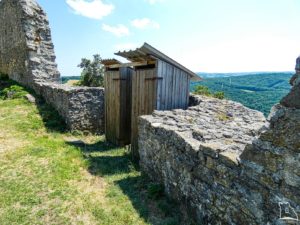Berencsváralja



Berencs castle was exchanged for Galgóc castle and its villages in 1297, the new owner was “Veres” (Red) Ábrahám, son of Cseklészi Majnold. After the Árpád Dynasty was discontinued in 1301, the mighty oligarch, Lord Csák Máté of Trencsén took the castle. He simply blackmailed the castle’s lord in 1309 who ceded the stronghold in exchange for another property. Soon, the Czech king took it from Lord Csák Máté in 1314. After 1321 Berencs became the property of the Hungarian kings who owned it between the 14th-15th centuries. The relatives of Csák Máté were able to hold Berencs until 1332. Then, the king enlarged it with new walls in 1335.

Anjou Maria (the wife of Magrev of Brandenburg, Sigismund of Luxembourg) and Queen Elisabeth pledged the entire Pozsony County in 1386 to Moravian Magraves called Jodok and Prokop, in exchange for military help. The Moravian troops marched in Berencs castle, too. Also, they took private castles by force. Three years later, King Sigismund paid the loan back and Jodok returned Pozsony (Pressburg, Bratislava) castle to the Hungarian Kingdom. Unlike him, Prokop was not willing to cede his castles so Zsigmond (Sigismund) led a military campaign against him. His troops besieged Berécs castle as well. Having taken it, the king gifted it to his Polish supporter, Comes Stibor of Pozsony in 1394 to consolidate his position against the rest of the Hungarian barons.

Baron Stíbor has become one of the mightiest lords in the following decade. He was called the “Lord of the Vág River”. He died in 1414 and was buried in Székesfehérvár, in the coronation cathedral of the Hungarian kings. Berencs castle and the rest of his lands were inherited by his son, Stibor who died in 1434 and was buried in Buda, in the church of the Great Virgin Mary (now also called Matthias church).

As the wealthy family was discontinued, the king inherited all the 11 domains they owned, except for Beckó and Detrekő castles. (You can read about them on my page, too.) For a time being, Berencs was pledged to Baron Szentmiklósi Pongrác, then he managed to buy it in 1453. Yet, Hunyadi János, Voivode of Transylvania became the new owner of Berencs in the following year, he obtained it by a barter. After his death, his widow, Lady Szilágyi Erzsébet gave Berencs back to Szentmiklósi Pongrác, to gain his support in 1457. She needed all help before the coronation of her son, Matthias Corvinus.

After this time, the Nyáry family became the owner of Berencs and its villages. They owned it until the Treasury inherited it from them. The castle was reinforced with Italian bastions in the 16th century. As the castle was located in the western part of Royal Hungary, it was not targeted by the Ottomans and there were no important battles in the area. Rather, it was the center of the local landlord. According to an inventory in 1669, the castle had three gates. The lower castle’s gate had a drawbridge, while there was a gate on the inner castle for the riders and another for the footmen. They listed also a small gate.

It was the prison of those Protestant ministers who had been accused of conspiracy against the Habsburg rulers during the Wesselényi Conspiracy. They were held in the dungeon, in terrible condition. The 67 preachers were sent to the galleys in 1674. The survivors were freed after a naval battle in 1676 when the Dutch General Ruyter saved them.

The castle was struck by lightning and burned down at the end of the 17th century. The archeological excavations began in the 1990s and by now (2019), you can see significant improvements in the castle. The castle stands on a 475-meter-high hill and it is definitely worth visiting.

Dear Readers, I can only make this content available through small donations or by selling my books or T-shirts:
Please, feel free to support me with a coffee here:
You can check out my books "33 Castles, Battles, Legends" and "The Ring of Kékkő Castle" on Amazon or Draft2Digital, they are available in hardcover, paperback, or ebook: https://www.amazon.com/dp/198020490X or at https://books2read.com/b/boYd81
 My work can also be followed and supported on Patreon: Become a Patron!http://Become a Patron!
My work can also be followed and supported on Patreon: Become a Patron!http://Become a Patron!


https://hungarianottomanwars.myspreadshop.com/all





























































